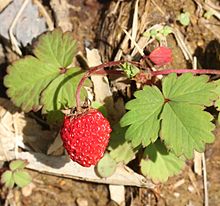Fragaria iinumae
| Fragaria iinumae | |
|---|---|

| |
| Scientific classification | |
| Kingdom: | Plantae |
| Clade: | Tracheophytes |
| Clade: | Angiosperms |
| Clade: | Eudicots |
| Clade: | Rosids |
| Order: | Rosales |
| Family: | Rosaceae |
| Genus: | Fragaria |
| Species: | F. iinumae
|
| Binomial name | |
| Fragaria iinumae | |
Fragaria iinumae is a species of strawberry native to Japan and eastern Russia.[1][2][3]
In Japan it was first discovered on Mount Nōgōhaku (能郷白山, Nōgōhaku-san) and the name Nōgō Fragaria (ノウゴウイチゴ・能郷苺, Nōgō Ichigo) was given.[4][5]
All strawberries have a base haploid count of 7 chromosomes. Fragaria iinumae is diploid, having 2 pairs of these chromosomes for a total of 14 chromosomes.[1][2][3] Fragaria iinumae is one of the diploid progenitors of the octoploid strawberry.[6]
-
Flower
-
Fruits
-
Montage
| NCBI genome ID | 24457 |
|---|---|
| Ploidy | diploid |
| Number of chromosomes | 14 |
| Year of completion | 2014 |
See also[edit]
References[edit]
Wikimedia Commons has media related to Fragaria iinumae.
Wikispecies has information related to Fragaria iinumae.
- ^ a b Oda, Y. (January 2002). "Photosynthetic characteristics and geographical distribution of diploid Fragaria species native in Japan". Acta Horticulturae (567): 381–384. doi:10.17660/ActaHortic.2002.567.83.
- ^ a b Sabitov, Andrey; Hummer, Kim E.; Davis, Tom (2005). "Iturup And Sakhalin Island Strawberries". HortScience. 40 (4): 1127. doi:10.21273/HORTSCI.40.4.1127A.
- ^ a b "Fragaria iinumae". Germplasm Resources Information Network. Agricultural Research Service, United States Department of Agriculture. Retrieved 2 January 2018.
- ^ Alpine plant in Japan (in Japanese). YAMA-KEI Publishers. 1994. ISBN 4-635-09019-1.
- ^ Alpen guide Mount Haku and mountains in Hokuriku (in Japanese). YAMA-KEI Publishers. 2000. ISBN 4-635-01321-9.
- ^ Rousseau-Gueutin, M.; Gaston, A.; Aïnouche, A.; Aïnouche, M. L.; Olbricht, K.; Staudt, G.; Richard, L.; Denoyes-Rothan, B. (1 June 2009). "Tracking the evolutionary history of polyploidy in Fragaria L. (strawberry): New insights from phylogenetic analyses of low-copy nuclear genes". Molecular Phylogenetics and Evolution. 51 (3): 515–530. doi:10.1016/j.ympev.2008.12.024. ISSN 1055-7903. PMID 19166953.




